Scientific Report: The Impact of Exertion on Student Heart Rate
VerifiedAdded on 2023/01/11
|10
|1784
|97
Report
AI Summary
This scientific report presents a study conducted on 36 university students to determine the impact of physical exertion on heart rate. The study employed both t-tests and chi-square tests to analyze the collected data. The methodology involved recording students' heart rates before and after physical activity to measure changes. The results, supported by statistical analysis, indicated a significant correlation between exertion and increased heart rate, leading to the acceptance of the alternative hypothesis. The report includes detailed statistical tables, interpretation of the findings, and a discussion of the results in relation to existing literature, ultimately concluding that exertion has a direct impact on heart rate due to increased energy consumption and blood circulation. The report also includes a comprehensive list of references.

Scientific report
Paraphrase This Document
Need a fresh take? Get an instant paraphrase of this document with our AI Paraphraser
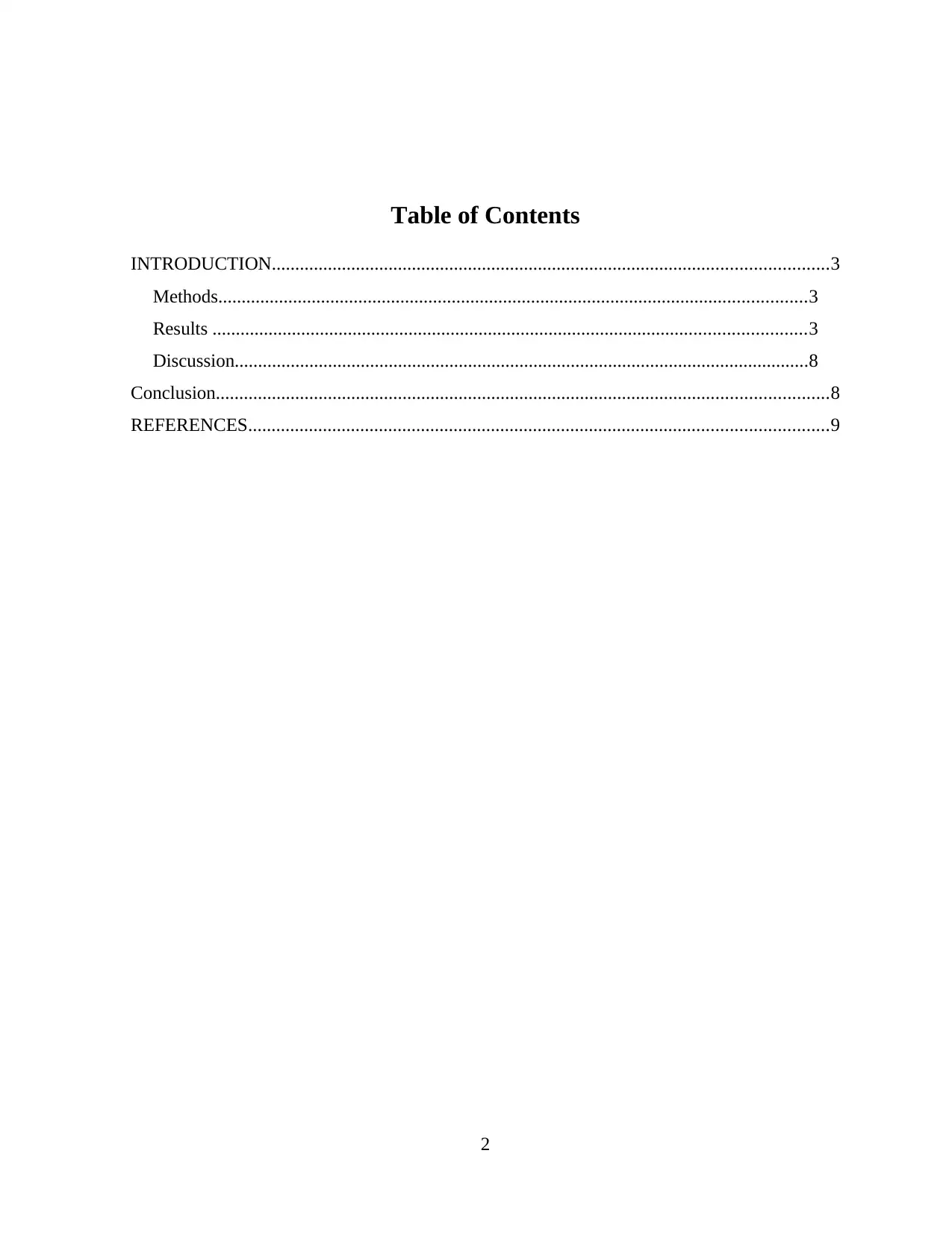
Table of Contents
INTRODUCTION.......................................................................................................................3
Methods..............................................................................................................................3
Results ...............................................................................................................................3
Discussion...........................................................................................................................8
Conclusion...................................................................................................................................8
REFERENCES............................................................................................................................9
2
INTRODUCTION.......................................................................................................................3
Methods..............................................................................................................................3
Results ...............................................................................................................................3
Discussion...........................................................................................................................8
Conclusion...................................................................................................................................8
REFERENCES............................................................................................................................9
2
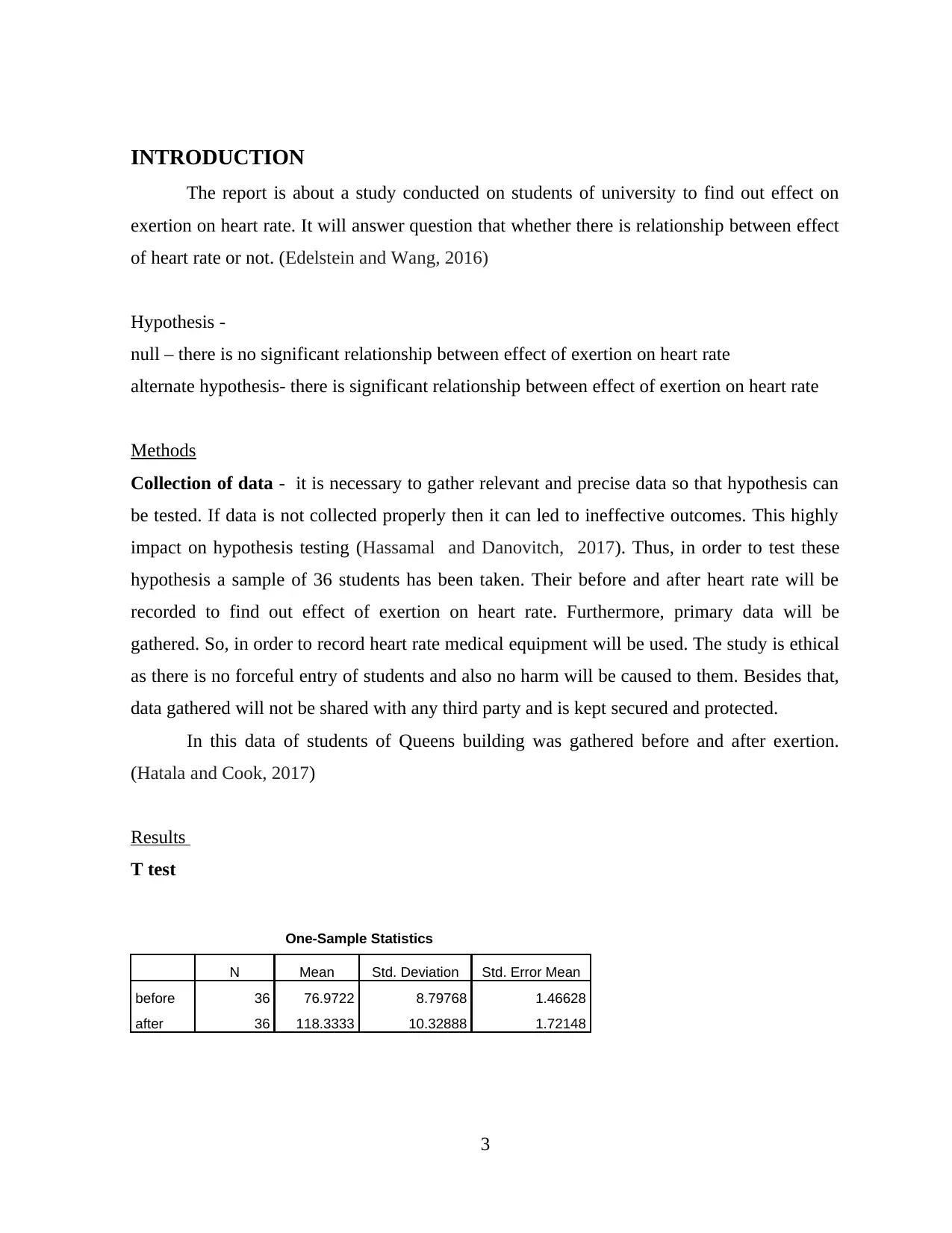
INTRODUCTION
The report is about a study conducted on students of university to find out effect on
exertion on heart rate. It will answer question that whether there is relationship between effect
of heart rate or not. (Edelstein and Wang, 2016)
Hypothesis -
null – there is no significant relationship between effect of exertion on heart rate
alternate hypothesis- there is significant relationship between effect of exertion on heart rate
Methods
Collection of data - it is necessary to gather relevant and precise data so that hypothesis can
be tested. If data is not collected properly then it can led to ineffective outcomes. This highly
impact on hypothesis testing (Hassamal and Danovitch, 2017). Thus, in order to test these
hypothesis a sample of 36 students has been taken. Their before and after heart rate will be
recorded to find out effect of exertion on heart rate. Furthermore, primary data will be
gathered. So, in order to record heart rate medical equipment will be used. The study is ethical
as there is no forceful entry of students and also no harm will be caused to them. Besides that,
data gathered will not be shared with any third party and is kept secured and protected.
In this data of students of Queens building was gathered before and after exertion.
(Hatala and Cook, 2017)
Results
T test
One-Sample Statistics
N Mean Std. Deviation Std. Error Mean
before 36 76.9722 8.79768 1.46628
after 36 118.3333 10.32888 1.72148
3
The report is about a study conducted on students of university to find out effect on
exertion on heart rate. It will answer question that whether there is relationship between effect
of heart rate or not. (Edelstein and Wang, 2016)
Hypothesis -
null – there is no significant relationship between effect of exertion on heart rate
alternate hypothesis- there is significant relationship between effect of exertion on heart rate
Methods
Collection of data - it is necessary to gather relevant and precise data so that hypothesis can
be tested. If data is not collected properly then it can led to ineffective outcomes. This highly
impact on hypothesis testing (Hassamal and Danovitch, 2017). Thus, in order to test these
hypothesis a sample of 36 students has been taken. Their before and after heart rate will be
recorded to find out effect of exertion on heart rate. Furthermore, primary data will be
gathered. So, in order to record heart rate medical equipment will be used. The study is ethical
as there is no forceful entry of students and also no harm will be caused to them. Besides that,
data gathered will not be shared with any third party and is kept secured and protected.
In this data of students of Queens building was gathered before and after exertion.
(Hatala and Cook, 2017)
Results
T test
One-Sample Statistics
N Mean Std. Deviation Std. Error Mean
before 36 76.9722 8.79768 1.46628
after 36 118.3333 10.32888 1.72148
3
⊘ This is a preview!⊘
Do you want full access?
Subscribe today to unlock all pages.

Trusted by 1+ million students worldwide

One-Sample Test
Test Value = 0
t df Sig. (2-tailed) Mean Difference 95% Confidence Interval of the
Difference
Lower Upper
before 52.495 35 .000 76.97222 73.9955 79.9489
after 68.739 35 .000 118.33333 114.8385 121.8281
Interpretation- From table it is analysed that there are significant value obtained in P = .000
which is less than P =0.05 thus alternative hypothesis is accepted. It means that there is effect
of exertion on heart rate. There is difference in before and after heart rate of students.
(Walston and Ely, 2017)
Chi square
Case Processing Summary
Cases
Valid Missing Total
N Percent N Percent N Percent
before * after 36 100.0% 0 0.0% 36 100.0%
before * after Crosstabulation
Count
after
98.00 99.00 101.00 104.00 106.00 108.00 109.00
before 62.00 0 0 0 0 0 0 0
64.00 0 0 0 0 0 0 0
65.00 1 0 0 0 0 0 0
66.00 0 1 0 0 0 0 0
68.00 0 0 0 0 0 0 1
70.00 0 0 1 0 0 0 0
4
Test Value = 0
t df Sig. (2-tailed) Mean Difference 95% Confidence Interval of the
Difference
Lower Upper
before 52.495 35 .000 76.97222 73.9955 79.9489
after 68.739 35 .000 118.33333 114.8385 121.8281
Interpretation- From table it is analysed that there are significant value obtained in P = .000
which is less than P =0.05 thus alternative hypothesis is accepted. It means that there is effect
of exertion on heart rate. There is difference in before and after heart rate of students.
(Walston and Ely, 2017)
Chi square
Case Processing Summary
Cases
Valid Missing Total
N Percent N Percent N Percent
before * after 36 100.0% 0 0.0% 36 100.0%
before * after Crosstabulation
Count
after
98.00 99.00 101.00 104.00 106.00 108.00 109.00
before 62.00 0 0 0 0 0 0 0
64.00 0 0 0 0 0 0 0
65.00 1 0 0 0 0 0 0
66.00 0 1 0 0 0 0 0
68.00 0 0 0 0 0 0 1
70.00 0 0 1 0 0 0 0
4
Paraphrase This Document
Need a fresh take? Get an instant paraphrase of this document with our AI Paraphraser
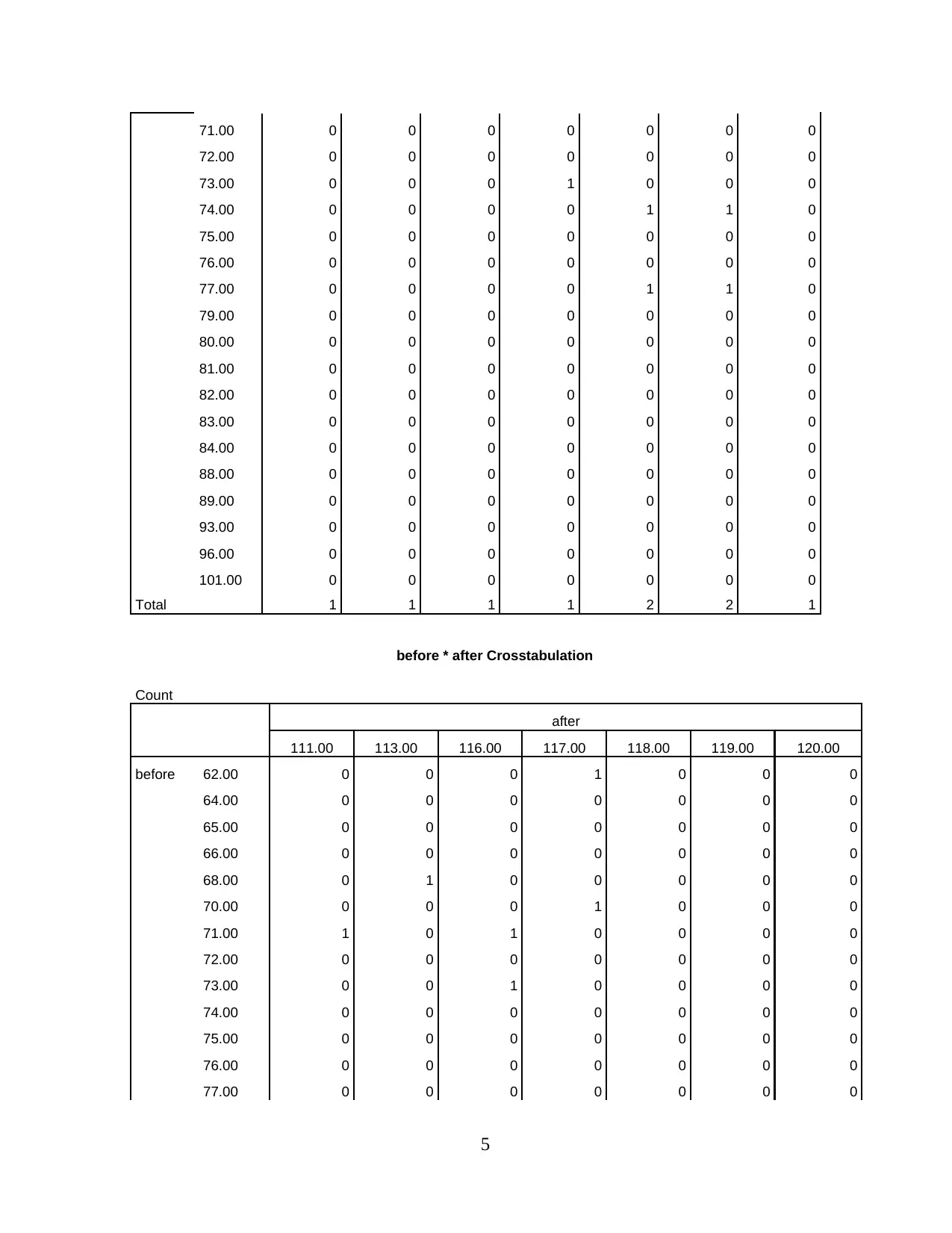
71.00 0 0 0 0 0 0 0
72.00 0 0 0 0 0 0 0
73.00 0 0 0 1 0 0 0
74.00 0 0 0 0 1 1 0
75.00 0 0 0 0 0 0 0
76.00 0 0 0 0 0 0 0
77.00 0 0 0 0 1 1 0
79.00 0 0 0 0 0 0 0
80.00 0 0 0 0 0 0 0
81.00 0 0 0 0 0 0 0
82.00 0 0 0 0 0 0 0
83.00 0 0 0 0 0 0 0
84.00 0 0 0 0 0 0 0
88.00 0 0 0 0 0 0 0
89.00 0 0 0 0 0 0 0
93.00 0 0 0 0 0 0 0
96.00 0 0 0 0 0 0 0
101.00 0 0 0 0 0 0 0
Total 1 1 1 1 2 2 1
before * after Crosstabulation
Count
after
111.00 113.00 116.00 117.00 118.00 119.00 120.00
before 62.00 0 0 0 1 0 0 0
64.00 0 0 0 0 0 0 0
65.00 0 0 0 0 0 0 0
66.00 0 0 0 0 0 0 0
68.00 0 1 0 0 0 0 0
70.00 0 0 0 1 0 0 0
71.00 1 0 1 0 0 0 0
72.00 0 0 0 0 0 0 0
73.00 0 0 1 0 0 0 0
74.00 0 0 0 0 0 0 0
75.00 0 0 0 0 0 0 0
76.00 0 0 0 0 0 0 0
77.00 0 0 0 0 0 0 0
5
72.00 0 0 0 0 0 0 0
73.00 0 0 0 1 0 0 0
74.00 0 0 0 0 1 1 0
75.00 0 0 0 0 0 0 0
76.00 0 0 0 0 0 0 0
77.00 0 0 0 0 1 1 0
79.00 0 0 0 0 0 0 0
80.00 0 0 0 0 0 0 0
81.00 0 0 0 0 0 0 0
82.00 0 0 0 0 0 0 0
83.00 0 0 0 0 0 0 0
84.00 0 0 0 0 0 0 0
88.00 0 0 0 0 0 0 0
89.00 0 0 0 0 0 0 0
93.00 0 0 0 0 0 0 0
96.00 0 0 0 0 0 0 0
101.00 0 0 0 0 0 0 0
Total 1 1 1 1 2 2 1
before * after Crosstabulation
Count
after
111.00 113.00 116.00 117.00 118.00 119.00 120.00
before 62.00 0 0 0 1 0 0 0
64.00 0 0 0 0 0 0 0
65.00 0 0 0 0 0 0 0
66.00 0 0 0 0 0 0 0
68.00 0 1 0 0 0 0 0
70.00 0 0 0 1 0 0 0
71.00 1 0 1 0 0 0 0
72.00 0 0 0 0 0 0 0
73.00 0 0 1 0 0 0 0
74.00 0 0 0 0 0 0 0
75.00 0 0 0 0 0 0 0
76.00 0 0 0 0 0 0 0
77.00 0 0 0 0 0 0 0
5
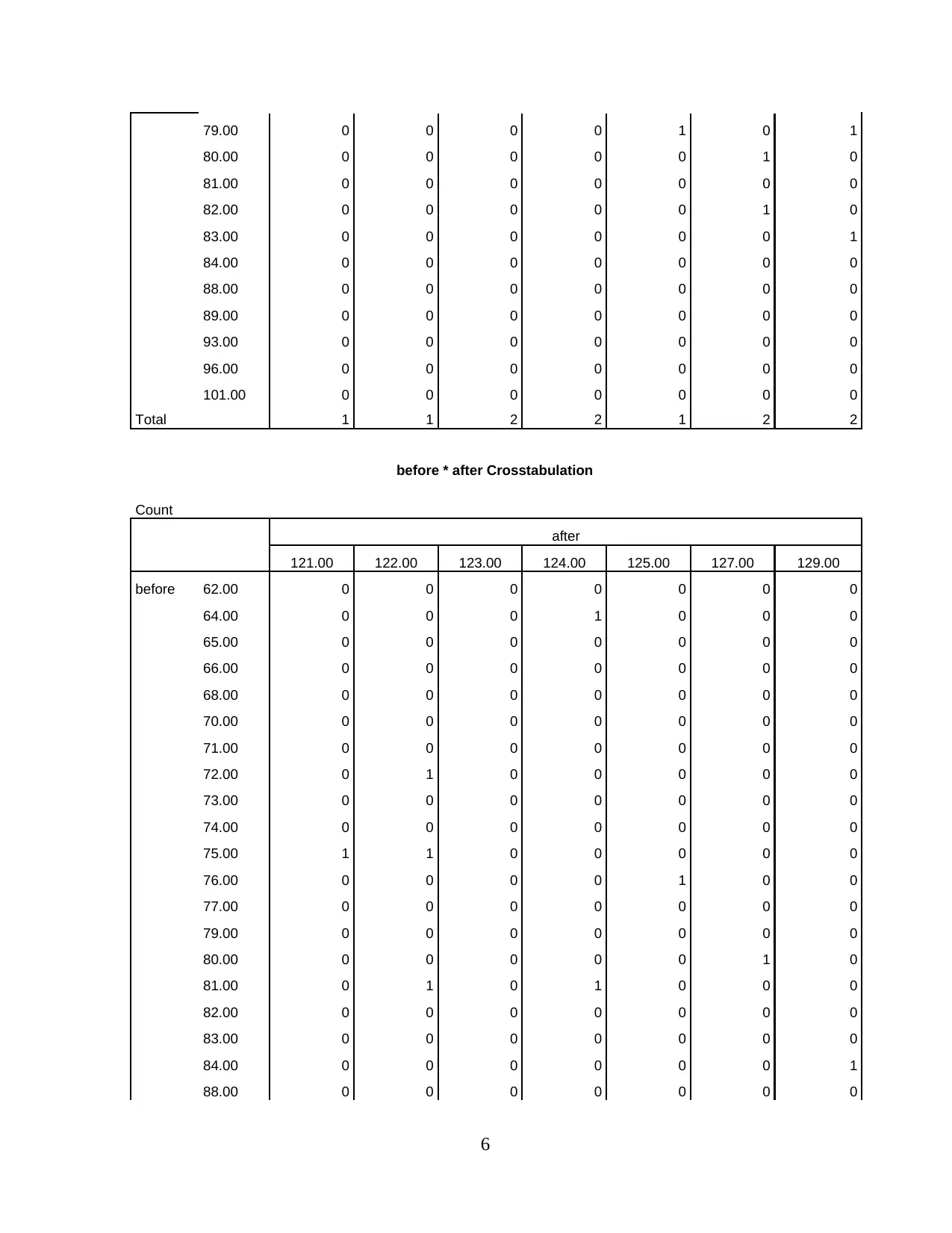
79.00 0 0 0 0 1 0 1
80.00 0 0 0 0 0 1 0
81.00 0 0 0 0 0 0 0
82.00 0 0 0 0 0 1 0
83.00 0 0 0 0 0 0 1
84.00 0 0 0 0 0 0 0
88.00 0 0 0 0 0 0 0
89.00 0 0 0 0 0 0 0
93.00 0 0 0 0 0 0 0
96.00 0 0 0 0 0 0 0
101.00 0 0 0 0 0 0 0
Total 1 1 2 2 1 2 2
before * after Crosstabulation
Count
after
121.00 122.00 123.00 124.00 125.00 127.00 129.00
before 62.00 0 0 0 0 0 0 0
64.00 0 0 0 1 0 0 0
65.00 0 0 0 0 0 0 0
66.00 0 0 0 0 0 0 0
68.00 0 0 0 0 0 0 0
70.00 0 0 0 0 0 0 0
71.00 0 0 0 0 0 0 0
72.00 0 1 0 0 0 0 0
73.00 0 0 0 0 0 0 0
74.00 0 0 0 0 0 0 0
75.00 1 1 0 0 0 0 0
76.00 0 0 0 0 1 0 0
77.00 0 0 0 0 0 0 0
79.00 0 0 0 0 0 0 0
80.00 0 0 0 0 0 1 0
81.00 0 1 0 1 0 0 0
82.00 0 0 0 0 0 0 0
83.00 0 0 0 0 0 0 0
84.00 0 0 0 0 0 0 1
88.00 0 0 0 0 0 0 0
6
80.00 0 0 0 0 0 1 0
81.00 0 0 0 0 0 0 0
82.00 0 0 0 0 0 1 0
83.00 0 0 0 0 0 0 1
84.00 0 0 0 0 0 0 0
88.00 0 0 0 0 0 0 0
89.00 0 0 0 0 0 0 0
93.00 0 0 0 0 0 0 0
96.00 0 0 0 0 0 0 0
101.00 0 0 0 0 0 0 0
Total 1 1 2 2 1 2 2
before * after Crosstabulation
Count
after
121.00 122.00 123.00 124.00 125.00 127.00 129.00
before 62.00 0 0 0 0 0 0 0
64.00 0 0 0 1 0 0 0
65.00 0 0 0 0 0 0 0
66.00 0 0 0 0 0 0 0
68.00 0 0 0 0 0 0 0
70.00 0 0 0 0 0 0 0
71.00 0 0 0 0 0 0 0
72.00 0 1 0 0 0 0 0
73.00 0 0 0 0 0 0 0
74.00 0 0 0 0 0 0 0
75.00 1 1 0 0 0 0 0
76.00 0 0 0 0 1 0 0
77.00 0 0 0 0 0 0 0
79.00 0 0 0 0 0 0 0
80.00 0 0 0 0 0 1 0
81.00 0 1 0 1 0 0 0
82.00 0 0 0 0 0 0 0
83.00 0 0 0 0 0 0 0
84.00 0 0 0 0 0 0 1
88.00 0 0 0 0 0 0 0
6
⊘ This is a preview!⊘
Do you want full access?
Subscribe today to unlock all pages.

Trusted by 1+ million students worldwide
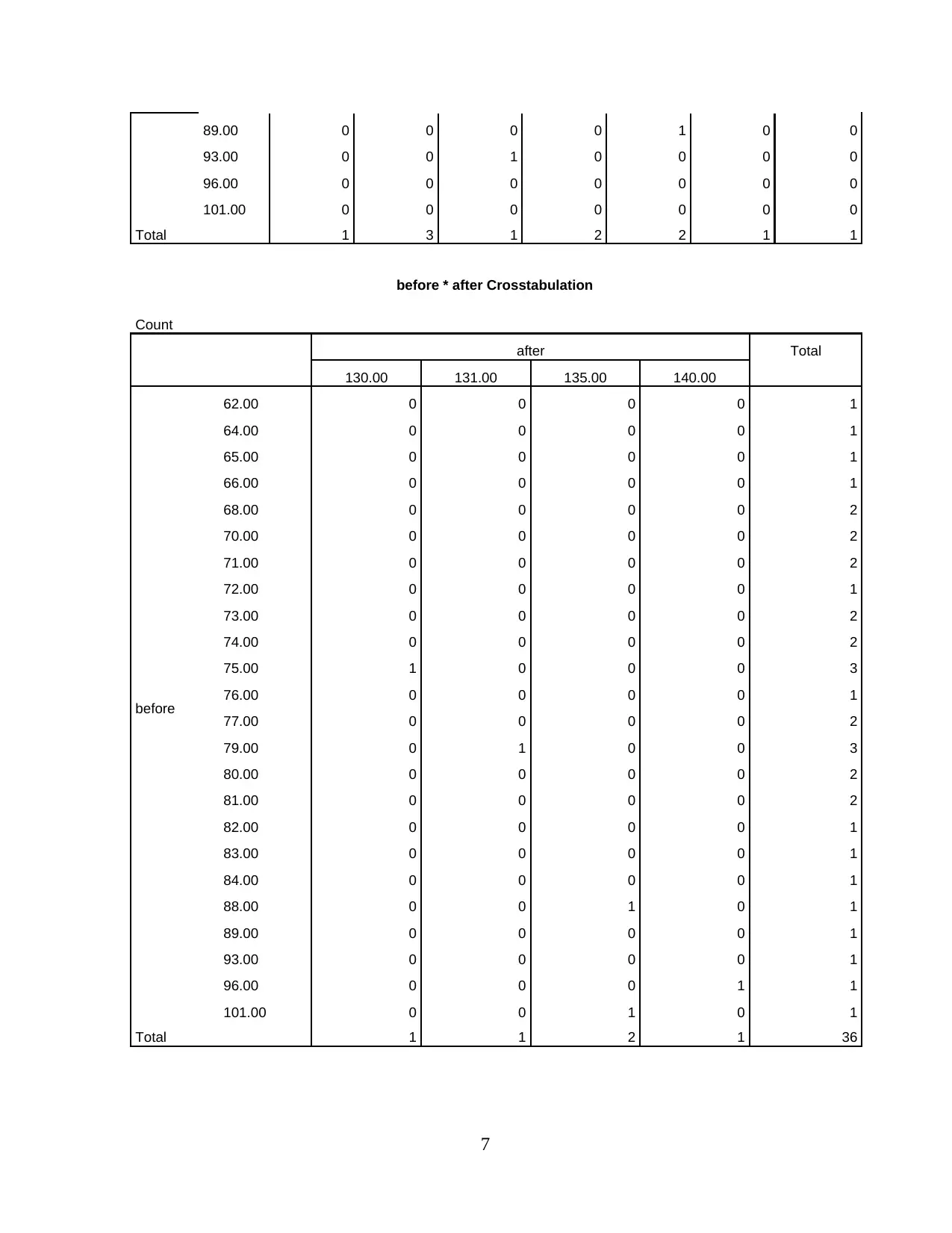
89.00 0 0 0 0 1 0 0
93.00 0 0 1 0 0 0 0
96.00 0 0 0 0 0 0 0
101.00 0 0 0 0 0 0 0
Total 1 3 1 2 2 1 1
before * after Crosstabulation
Count
after Total
130.00 131.00 135.00 140.00
before
62.00 0 0 0 0 1
64.00 0 0 0 0 1
65.00 0 0 0 0 1
66.00 0 0 0 0 1
68.00 0 0 0 0 2
70.00 0 0 0 0 2
71.00 0 0 0 0 2
72.00 0 0 0 0 1
73.00 0 0 0 0 2
74.00 0 0 0 0 2
75.00 1 0 0 0 3
76.00 0 0 0 0 1
77.00 0 0 0 0 2
79.00 0 1 0 0 3
80.00 0 0 0 0 2
81.00 0 0 0 0 2
82.00 0 0 0 0 1
83.00 0 0 0 0 1
84.00 0 0 0 0 1
88.00 0 0 1 0 1
89.00 0 0 0 0 1
93.00 0 0 0 0 1
96.00 0 0 0 1 1
101.00 0 0 1 0 1
Total 1 1 2 1 36
7
93.00 0 0 1 0 0 0 0
96.00 0 0 0 0 0 0 0
101.00 0 0 0 0 0 0 0
Total 1 3 1 2 2 1 1
before * after Crosstabulation
Count
after Total
130.00 131.00 135.00 140.00
before
62.00 0 0 0 0 1
64.00 0 0 0 0 1
65.00 0 0 0 0 1
66.00 0 0 0 0 1
68.00 0 0 0 0 2
70.00 0 0 0 0 2
71.00 0 0 0 0 2
72.00 0 0 0 0 1
73.00 0 0 0 0 2
74.00 0 0 0 0 2
75.00 1 0 0 0 3
76.00 0 0 0 0 1
77.00 0 0 0 0 2
79.00 0 1 0 0 3
80.00 0 0 0 0 2
81.00 0 0 0 0 2
82.00 0 0 0 0 1
83.00 0 0 0 0 1
84.00 0 0 0 0 1
88.00 0 0 1 0 1
89.00 0 0 0 0 1
93.00 0 0 0 0 1
96.00 0 0 0 1 1
101.00 0 0 1 0 1
Total 1 1 2 1 36
7
Paraphrase This Document
Need a fresh take? Get an instant paraphrase of this document with our AI Paraphraser
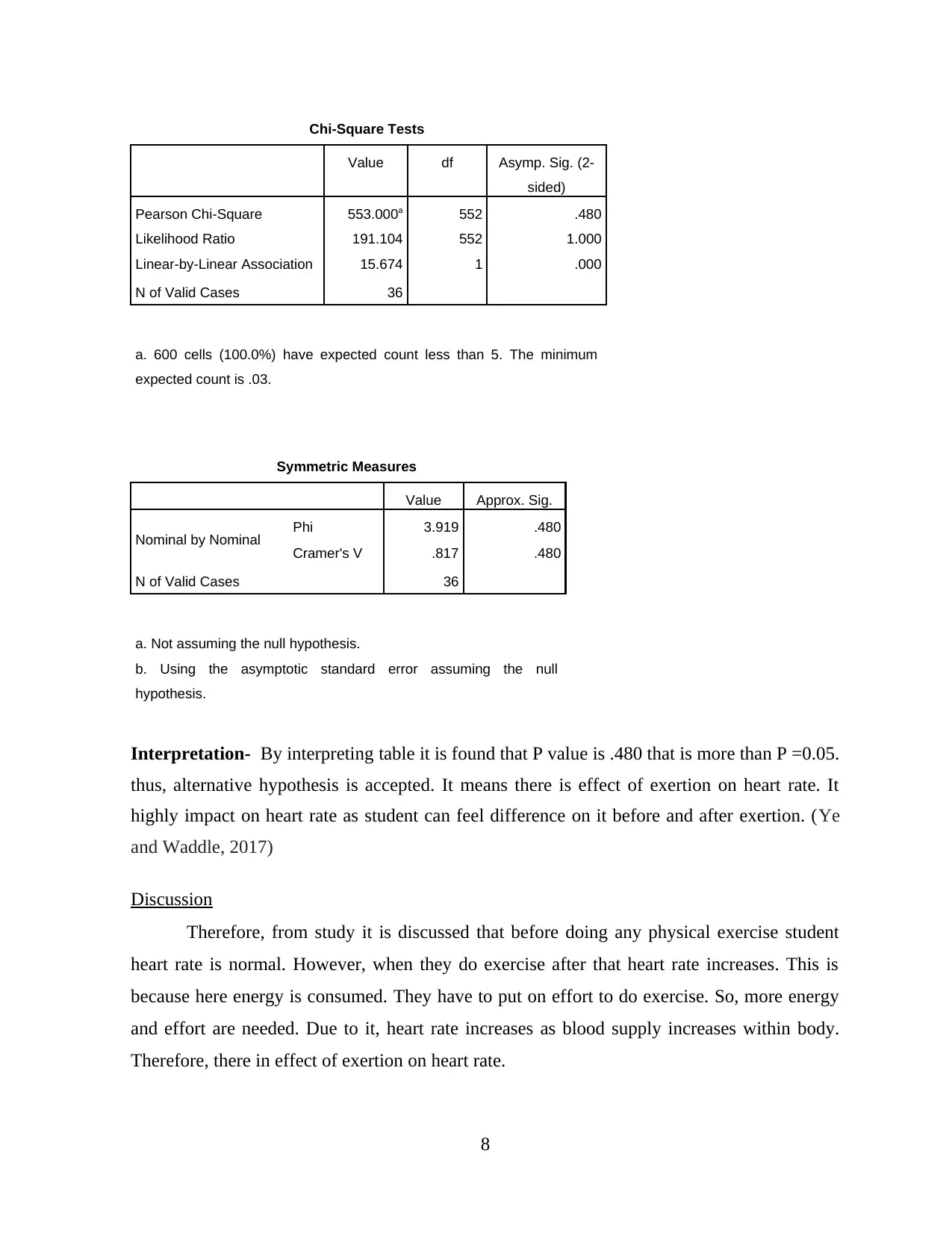
Chi-Square Tests
Value df Asymp. Sig. (2-
sided)
Pearson Chi-Square 553.000a 552 .480
Likelihood Ratio 191.104 552 1.000
Linear-by-Linear Association 15.674 1 .000
N of Valid Cases 36
a. 600 cells (100.0%) have expected count less than 5. The minimum
expected count is .03.
Symmetric Measures
Value Approx. Sig.
Nominal by Nominal Phi 3.919 .480
Cramer's V .817 .480
N of Valid Cases 36
a. Not assuming the null hypothesis.
b. Using the asymptotic standard error assuming the null
hypothesis.
Interpretation- By interpreting table it is found that P value is .480 that is more than P =0.05.
thus, alternative hypothesis is accepted. It means there is effect of exertion on heart rate. It
highly impact on heart rate as student can feel difference on it before and after exertion. (Ye
and Waddle, 2017)
Discussion
Therefore, from study it is discussed that before doing any physical exercise student
heart rate is normal. However, when they do exercise after that heart rate increases. This is
because here energy is consumed. They have to put on effort to do exercise. So, more energy
and effort are needed. Due to it, heart rate increases as blood supply increases within body.
Therefore, there in effect of exertion on heart rate.
8
Value df Asymp. Sig. (2-
sided)
Pearson Chi-Square 553.000a 552 .480
Likelihood Ratio 191.104 552 1.000
Linear-by-Linear Association 15.674 1 .000
N of Valid Cases 36
a. 600 cells (100.0%) have expected count less than 5. The minimum
expected count is .03.
Symmetric Measures
Value Approx. Sig.
Nominal by Nominal Phi 3.919 .480
Cramer's V .817 .480
N of Valid Cases 36
a. Not assuming the null hypothesis.
b. Using the asymptotic standard error assuming the null
hypothesis.
Interpretation- By interpreting table it is found that P value is .480 that is more than P =0.05.
thus, alternative hypothesis is accepted. It means there is effect of exertion on heart rate. It
highly impact on heart rate as student can feel difference on it before and after exertion. (Ye
and Waddle, 2017)
Discussion
Therefore, from study it is discussed that before doing any physical exercise student
heart rate is normal. However, when they do exercise after that heart rate increases. This is
because here energy is consumed. They have to put on effort to do exercise. So, more energy
and effort are needed. Due to it, heart rate increases as blood supply increases within body.
Therefore, there in effect of exertion on heart rate.
8

Conclusion
It is summarised that exertion is doing of exercise. Thus, it directly impact on heart
rate as energy is consumed and blood circulation increases. Hence, alternative hypothesis is
accepted as there is effect on exertion on heart rate.
9
It is summarised that exertion is doing of exercise. Thus, it directly impact on heart
rate as energy is consumed and blood circulation increases. Hence, alternative hypothesis is
accepted as there is effect on exertion on heart rate.
9
⊘ This is a preview!⊘
Do you want full access?
Subscribe today to unlock all pages.

Trusted by 1+ million students worldwide
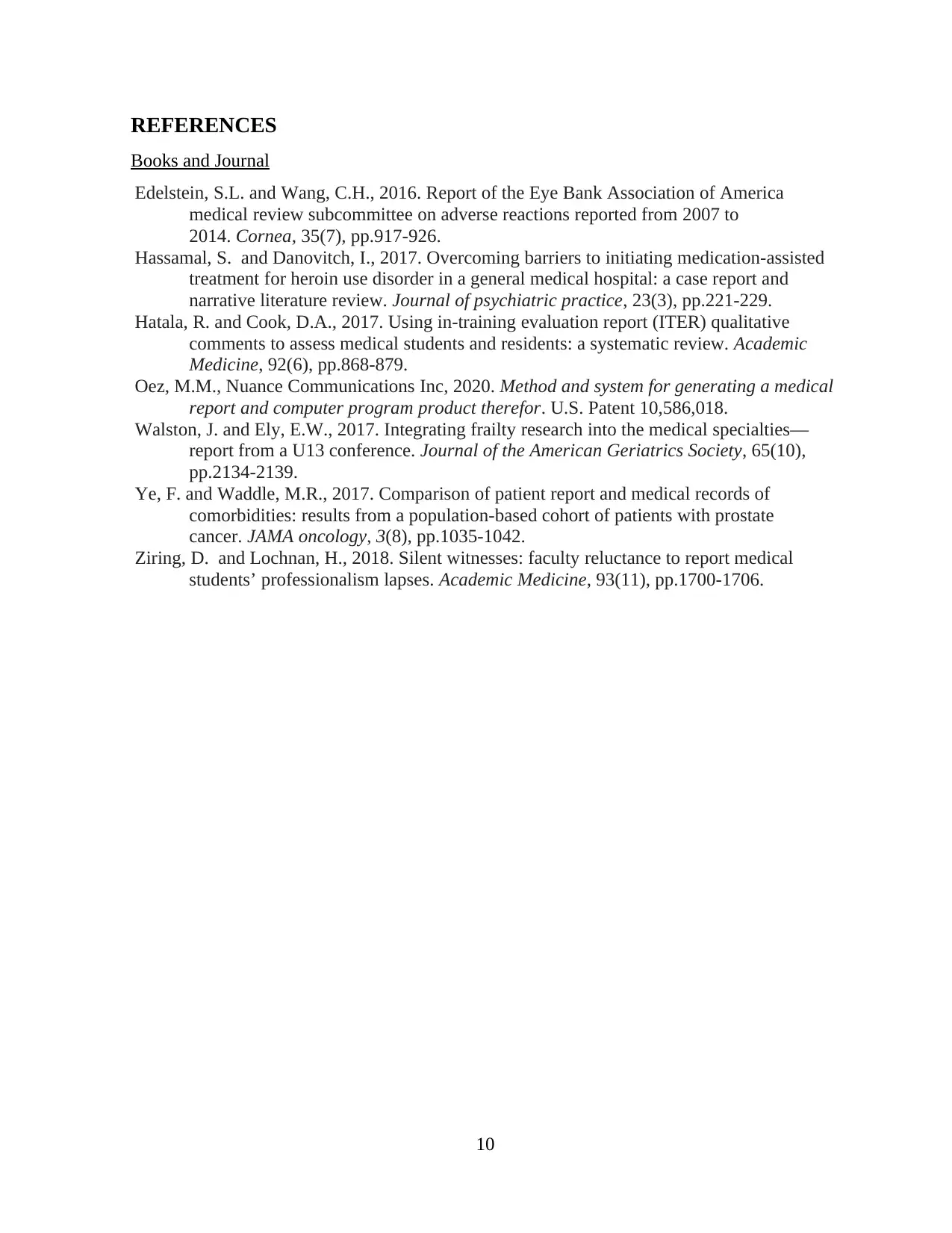
REFERENCES
Books and Journal
Edelstein, S.L. and Wang, C.H., 2016. Report of the Eye Bank Association of America
medical review subcommittee on adverse reactions reported from 2007 to
2014. Cornea, 35(7), pp.917-926.
Hassamal, S. and Danovitch, I., 2017. Overcoming barriers to initiating medication-assisted
treatment for heroin use disorder in a general medical hospital: a case report and
narrative literature review. Journal of psychiatric practice, 23(3), pp.221-229.
Hatala, R. and Cook, D.A., 2017. Using in-training evaluation report (ITER) qualitative
comments to assess medical students and residents: a systematic review. Academic
Medicine, 92(6), pp.868-879.
Oez, M.M., Nuance Communications Inc, 2020. Method and system for generating a medical
report and computer program product therefor. U.S. Patent 10,586,018.
Walston, J. and Ely, E.W., 2017. Integrating frailty research into the medical specialties—
report from a U13 conference. Journal of the American Geriatrics Society, 65(10),
pp.2134-2139.
Ye, F. and Waddle, M.R., 2017. Comparison of patient report and medical records of
comorbidities: results from a population-based cohort of patients with prostate
cancer. JAMA oncology, 3(8), pp.1035-1042.
Ziring, D. and Lochnan, H., 2018. Silent witnesses: faculty reluctance to report medical
students’ professionalism lapses. Academic Medicine, 93(11), pp.1700-1706.
10
Books and Journal
Edelstein, S.L. and Wang, C.H., 2016. Report of the Eye Bank Association of America
medical review subcommittee on adverse reactions reported from 2007 to
2014. Cornea, 35(7), pp.917-926.
Hassamal, S. and Danovitch, I., 2017. Overcoming barriers to initiating medication-assisted
treatment for heroin use disorder in a general medical hospital: a case report and
narrative literature review. Journal of psychiatric practice, 23(3), pp.221-229.
Hatala, R. and Cook, D.A., 2017. Using in-training evaluation report (ITER) qualitative
comments to assess medical students and residents: a systematic review. Academic
Medicine, 92(6), pp.868-879.
Oez, M.M., Nuance Communications Inc, 2020. Method and system for generating a medical
report and computer program product therefor. U.S. Patent 10,586,018.
Walston, J. and Ely, E.W., 2017. Integrating frailty research into the medical specialties—
report from a U13 conference. Journal of the American Geriatrics Society, 65(10),
pp.2134-2139.
Ye, F. and Waddle, M.R., 2017. Comparison of patient report and medical records of
comorbidities: results from a population-based cohort of patients with prostate
cancer. JAMA oncology, 3(8), pp.1035-1042.
Ziring, D. and Lochnan, H., 2018. Silent witnesses: faculty reluctance to report medical
students’ professionalism lapses. Academic Medicine, 93(11), pp.1700-1706.
10
1 out of 10
Related Documents
Your All-in-One AI-Powered Toolkit for Academic Success.
+13062052269
info@desklib.com
Available 24*7 on WhatsApp / Email
![[object Object]](/_next/static/media/star-bottom.7253800d.svg)
Unlock your academic potential
Copyright © 2020–2025 A2Z Services. All Rights Reserved. Developed and managed by ZUCOL.





